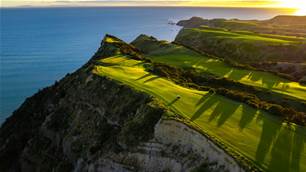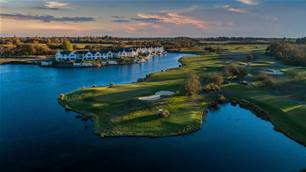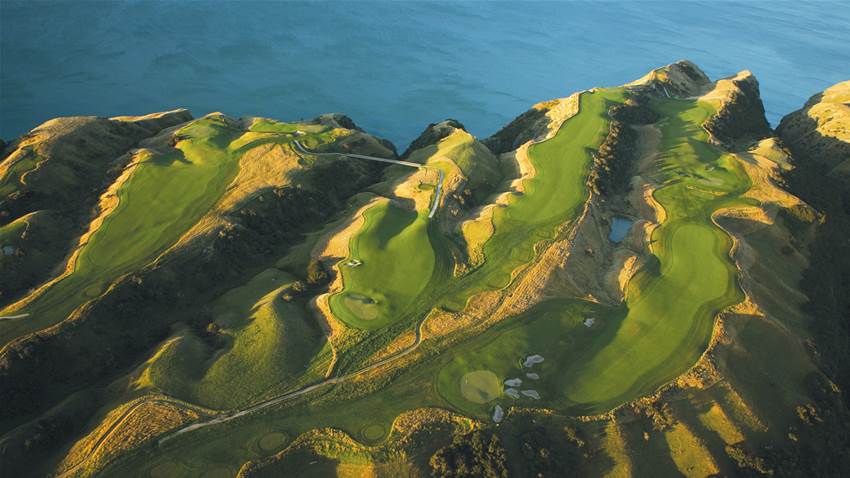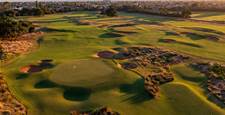There are more than 1,800 golf courses in Australia and New Zealand, but only a small percentage have the ingredients – the setting, history, dramatic holes, the tournament dramas – that combine to take your breath away during a round.
ST ANDREWS BEACH
Fingal, Victoria
Imagine the dilemma … you have to design a golf course on land so good, it becomes a challenge to leave holes out of the mix.
That’s what American designer Tom Doak faced at St Andrews Beach.
“The land here was so good for designing a golf course that it became difficult
to decide which holes we couldn’t build,” he said.
“In some cases, we just had to find the right spot to put a green, locate the nearest high point near that green to put the next tee and the following hole would present itself. I can’t help but feel that Alister Mackenzie would be mad that he never got the chance to design a course on land this good.”
So, if Doak had to reject some good holes, the ones that have been left behind must be great. They are and, as a result, St Andrews Beach has been cemented in the top-20 ranked courses in Australia since it opened in 2005.

TARA ITI GC
Mangawhai, North Island, NZ
Here is yet another Tom Doak-designed gem that lies by the sea and fills the nostrils with the smell of links golf.
Acres of non-native pine and wattle trees were removed (in some cases buried to form huge sand dunes), leaving a sandy site that was revegetated with fescue grass, spinifex and other native plants.
Doak’s creation is relatively simple – there are no trees, water hazards or penal rough, just fairways, greens and tees. There is, however, plenty of sand away from the best playing lines … beautiful big areas of sandy wasteland that look like they have been there for hundreds of years.
Like so many of the courses featured here, Tara Iti has plenty of highlights (so it shouldn’t surprise it is New Zealand’s No.1 ranked course) but the beachside par-5 6th with its dramatically rumpled fairway is one hole you will find hard to forget.

THE COAST GC
Little Bay, NSW
The Coast is not a long golf course, but its challenge comes in controlling your ball in the inevitable wind that comes from playing by the sea.
Panoramic ocean views are readily available from all corners of the layout but the crashing waves on the shore really only become noticeable when you reach the 4th tee. The 183-metre par-3 is one of only a handful of holes in Australia where you play so close to the ocean you can feel the sea spray on a choppy day. Here, the tee shot is played along the edge of the rocky coastline and is totally exposed to the elements. It will simply take your breath away.

THE CUT GC
Port Bouvard, WA
The Cut is a course of contrasting landscapes – there are the visually stunning oceanside holes, a stretch of five holes in a residential estate and arguably one of the best back nine stretches to be found in Australia.
The inward half at The Cut ramps up the excitement with holes that are more undulating than the outward nine and dense walls of native shrubs lining most of the fairways.
High dunes play a major role in James Wilcher’s design, as do a combination of natural wild bunkering and manicured traps, which punctuate strategic points en route between tee and green on every hole.

THE DUNES LINKS
Rye, Victoria
Lying in the heart of treasured golfing terrain on Victoria’s Mornington Peninsula, The Dunes is a beautiful natural course that winds through valleys and over large dunes.
It’s designer, Tony Cashmore, is humble when talking of his role, saying he just chose the spots for the greens and tees “God did the rest … we just mowed everything in between.”
The outstanding highlight of a round at The Dunes is Cashmore’s trademark natural bunkering – a combination of wild rugged expanses of sand with well-placed deep pot bunkers that are designed to intimidate and penalise mis-hits.

THE HILLS GC
Arrowtown, South Island, NZ
Natural landmarks like The Remarkables, Coronet’s Peak and Crown Range, all create a natural amphitheatre around The Hills.
The Hills is the pride and joy of jewellery entrepreneur Michael Hill, who spared no expense in creating the brilliant layout, which is dotted with native and exotic trees including Lombardy poplars, Golden and Tortured willows, Flowering hawthorn, Maples and Sequoia.
In addition to its spectacular surrounds and the outstanding design of the layout, golfers are treated to various art works – created by Hill’s son, Mark – scattered around the course.

THE LAKES GC
Eastlakes, NSW
The Lakes – with water coming into play on half its holes – is one of Sydney’s iconic courses, having gained plenty of fame over the decades as a regular host venue for the Australian Open.
But it has achieved its biggest accolades since Mike Clayton redesigned the layout in the mid 2000s, exposing the open sandy wastelands of the original course, which had disappeared under the trees.
Clayton has opened up vast tracts of the course that were hidden by trees and scrub for decades, which has widened the playing lines and mis-hits are no longer lost in scrub but players must now fashion a recovery from an uneven, sandy lie or from long grass.

THE NATIONAL GC – Gunnamatta Course
Cape Schanck, Victoria
Less than two years after it officially opened for play, Tom Doak’s extensive reworking of the club’s Ocean Course has gained a reputation for being one of the country’s most fun courses to play.
Golf Australia magazine Top-100 judge Brian Walshe nailed it in his summation of the layout. “Gunnamatta is about width and angles into brilliant greens surrounded by fescue that emphasises the ground game. From the gorgeous drivable 2nd, with the green tucked a couple of metres from the out-of-bounds fence, to the stunning skyline green on 16 with Bass Strait as the backdrop, Gunnamatta is about as much fun as you can have on a golf course.”

THE NATIONAL GC – Moonah Course
Cape Schanck, Victoria
This Greg Norman and Bob Harrison-designed jewel is a links course laid over some of the most exhilarating, dramatic dunes to be found on the Mornington Peninsula.
There is not one hole among the 18 that does not stop you in your tracks and ask you to admire it for a while and whisper “wow”. The design team did a remarkable job finding the greatest number of natural holes, dictated by the landscape.
The wild bunkering and deep rough wide of each fairway, conjure thoughts of Royal County Down in Northern Ireland. Add the dunes of England’s Royal Birkdale and you have a contender for the world’s top-100 courses.

THE NATIONAL GC – Old Course
Cape Schanck, Victoria
American course architect Robert Trent Jones Jnr was thrilled when he was commissioned to create what is now known as the Old course.
He famously told the founding members: “any golf course architect would kill for a piece of land like this. It is one of the most unique areas of links country left anywhere in the world.”
The Old course covers high, rolling land covered by dense ti-tree and ancient Moonah trees, some of which have been found to date back 1,000 years. Bass Strait provides a stunning backdrop to most of the layout as it rises and falls from one ridge to another. The elevation change from tee to green on many holes is so great it is like riding a roller-coaster in slow motion.

THIRTEENTH BEACH LINKS – Beach Course
Barwon Heads, Victoria
Course designer Tony Cashmore gained wide acclaim for his creation at The Dunes, much of which he attributed to Mother Nature.
He brought those creative juices to Thirteenth Beach and the Beach course where he worked again with what Mother Nature provided. The bunkering is proof of this as they look like they have been in existence as part of the landscape for hundreds of years.
The Beach course offers a fantastic mix of holes – breathtaking par-3s, brutally long as well as quirky short par-4s and genuine three-shot par-5s that demand accuracy not power hitting to better par.

TITIRANGI GC
Auckland, North Island, NZ
New Zealand also benefited from Alister MacKenzie’s visit Down Under in 1926.
Having learned the ‘Good Doctor’ was in Australia, the directors of Auckland’s Titirangi Golf Club arranged for MacKenzie to stop over on his return voyage to the United States. He stayed for nearly a month.
Of his visit, MacKenzie wrote: “on the Fringe of Heaven (better known in Maori as Titirangi) the ground was exceptionally well adapted for golf … it is undulating without being hilly and has many natural features such as ravines of a bold and impressive nature.”
In the 1990s, English-born course designer Chris Pitman, using MacKenzie’s original sketches, embarked on an almost decade long redesign of Titirangi with brilliant results.

VICTORIA GC
Cheltenham, Victoria
Victoria has had several incarnations in the nine decades since it was first created, with a bunker plan provided by Dr Alister MacKenzie.
But it is in its current form – a major redesign completed in 2019 by Ogilvy, Clayton, Cocking & Mead (OCCM) – that has created an international buzz about the wonderful layout.
The greens were all converted from poa annua to Pure Distinction – a creeping bentgrass – and the surface area of most greens was also increased by extending the putting surfaces right to the edge of bunker lips, increasing the strategic angles for approach shots into the greens. What has always been a great shot-makers course is now even better and great fun to play.

WAIRAKEI GOLF
Lake Taupo, North Island, NZ
Wairakei, New Zealand’s original resort course, is a visually striking and challenging layout created by designer Commander John Harris in collaboration with five-time Open champion Peter Thomson and then US Tour player, Mike Wolveridge.
Set in a valley surrounded by pine forest covered mountains; the layout is immaculately presented and complements a superb design that certainly rates among Thomson and Wolveridge’s best works.
The terrain becomes more dramatic away from the clubhouse as the holes wind across, up and down the foothills, while the bunkering is not overdone and strategically placed. All the greenside bunkers are steep faced and are unique as they are lined with the trunks of native Punga ferns.

Related Articles

Course Review: Cape Kidnappers

Review: Clearwater Golf Club













